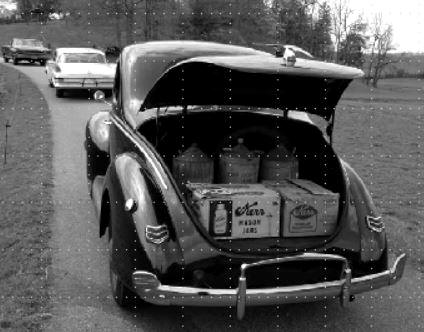
Hot Rod Magazine Website
Willie Clay Call’s potent 1940 Ford Tudor was a quick
way to get squeezins from one point to another.
BILL'S
[Somewhat] WEEKLY COLUMN/BLOG PAGE
BILL’S BACK IN TIME
By Bill Ladabouche
MORRISVILLE RACEWAY
THE SHORT LIFE OF AN OLD TRACK IN MORRISVILLE
| If you have read this one before, please accept my apologies. I looked for evidence it had been used already and couldn't find any. |
In the 1940s, stock auto racing
was beginning to see an explosion in various parts of the country. In Florida, a
man named Bill France was organizing what would become NASCAR (National
Association of Stock Car Racing). Open wheel racers had already made
Indianapolis famous, but by the '40, folks were realizing they could race
whatever car they had, where ever they were located.
The roots of stock car racing
are often traced back to the moonshine days of the South. Guys like Junior
Johnson first learned to drive fast and trick up their cars, out-running the law
as they carried their homemade corn squeezin's to yet another late night
clandestine rendezvous.

Hot Rod Magazine Website
Willie Clay Call’s potent 1940 Ford
Tudor was a quick
way to get squeezins from one point to another.
Times changes as prohibition became a distant memory, and white lightning became harder to find. People began organizing "races" for these guys. While the South gets all the credit, the same thing was happening all around the country, even in New England, even in Vermont, and even in Morrisville. Lamoille County's affection for auto racing didn't begin when Thunder Road in Barre opened its doors. By 1950, Morrisville an unofficial section of Morrisville, was home to its own homegrown, rudimentary racetrack.
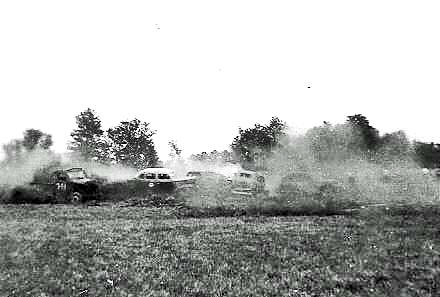
Courtesy of Charlie Smith
Stock cars mix it up on the track
in Morrisville.
On Sunday afternoons, the fields roughly near where the Bishop John A. Marshall school now sits were abuzz with the sound of revving motors and the cheers (and often jeers) of large crowds of spectators. Clarence "C. C." Miller, a local cattle dealer, owned the property and fashioned the track for racing enthusiasts from around north central Vermont. Howard Conley, of Barton, promoted the events. The presence and influence of Conley, no doubt attracted mainly drivers and cars from up in his territory – especially in the first weeks of the track.
Long before the glitz and glamour of CBS and the Daytona 500, Ken Squier could be found on the back of a flatbed truck, calling the action at Morrisville's racetrack. At only 14 or 15 years old, he most likely was one of the youngest announcers working the racing circuit. Squier remembers his days in that field well. Although when asked how a 14 year old boy could get a job as the track announcer, he couldn't quite remember. "It was probably because they didn't have one," said the owner of WDEV AM/FM and WLVB.
Courtesy of Cho Lee
Already a veteran of many races
called, a very young Ken
Squier interviews a winning driver in Keene, NH
The way the story [from another source] seems to go, Conley was running around doing everything. He apparently worked under the old adage that – if you wanted something done right, - you did it yourself. Some sort of major problem sprang up that did not necessitate the stoppage of the on – going race program. Desperate to act immediately, Conley turned around and handed the announcer’s microphone he had been manning to a teenager sitting beside him, a boy whose constant presence among the track managers made him a familiar figure.
To everyone’s amazement, the youngster took the mike and proceeded to spiel out an effective, exciting, and interesting account of the racing action going on in front of him. From that point on the radio station owner’s kid from Stowe was the track announcer, and – not much later – he was handling announcing at tracks all over the northeast, ranging as far south as Cheshire fairgrounds, Keene, NH. He would also be involved with tracks, far to the west, in the town of Colchester in Chittenden County.
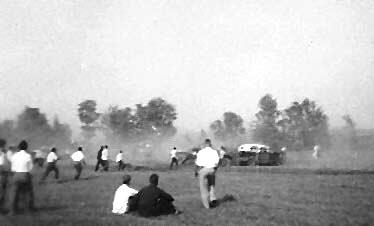
Courtesy of Charlie Smith
This photo shows the total lack of
infrastructure and the potential for spectator involvement and
injury as onlookers stream out to the track as the dust from an accident has not
even settled yet.
The layout was fairly simple as Squier recalls. A
bulldozer stripped a circle of grass to create the oval. Turns three and four
sat near the Laporte Road, turns one and two were down by the trees along Ryder
Brook. The pit area was between the first and second turns and the trees. There
were no grandstands for the many spectators who would turn out each week (about
300-400), but a chicken wire fence "protected" the fans from the cars. Racing
back then was not very organized. That is, the rules were flexible. Races would
start about noon and run until dark. The drivers would draw for starting
positions. The race cars being driven were archaic compared to today's high-tech
machines.
"They
were not stock cars like we know it," said Squier, “the cars on the Morrisville
oval were a lot like the cars the spectators drove to the event. The cars had
little or no roll bars, in fact quite often, he said, they didn't even have
brakes or floorboards. The original racers on the track came down from the
Northeast Kingdom. At the time, There was an existing track in Lyndonville, and
one at the Newport Ballpark [actually, the old Veterans’ Park horse track
facility]. ”
Ken Hitchcock Collection
The drivers who came down from the
Newport area had
heavy cars, often braced on the outside.
"Two or three of the drivers were from the Barton
area," recalls Squier. “The northern cars were big and heavy.”
There were other tracks in
the area as well, Sheldon Springs, Colchester, South Burlington, and Malletts
Bay. Northfield had a fairly large track; Dog River was its name. After a few
races had been run in Morrisville, cars started arriving from the Chittenden
County area, too. Squier said these cars were smaller and lighter, and began
beating the Newport regulars. Trouble was brewing.
The Sheldon tracks and the one in Northfield seemed to do the most to pave the way for the Morrisville facility to be developed. Northfield allegedly hosted the first formal stock car race, some time in the late 1940’s. It was at the Green Mountain Speedway, on a farm in Sheldon, where the northerners first started racing in with the Chittenden county teams. Early stars like Jackie Peterson, Gordy Owen, Frank Hart, and Ronnie Farnsworth would share the track with Harold Cannonball Baker, Basil Royer, and others from nearer by.
Over time, a small civil war began to develop, as the Chittenden County faction began feuding with the Northeast Kingdom faction. The feud escalated to the point where the Kingdom drivers brought in a "ringer" to help gain an advantage over the Chittenden County hotshoes. Henry Whipple, father of current racing journalist, Phil, has claimed to be the person who brought in this ringer. Albert "Killer" Kincaid came down from Newport in his car dubbed the "Lucky Old Son." [A very French sounding thing]
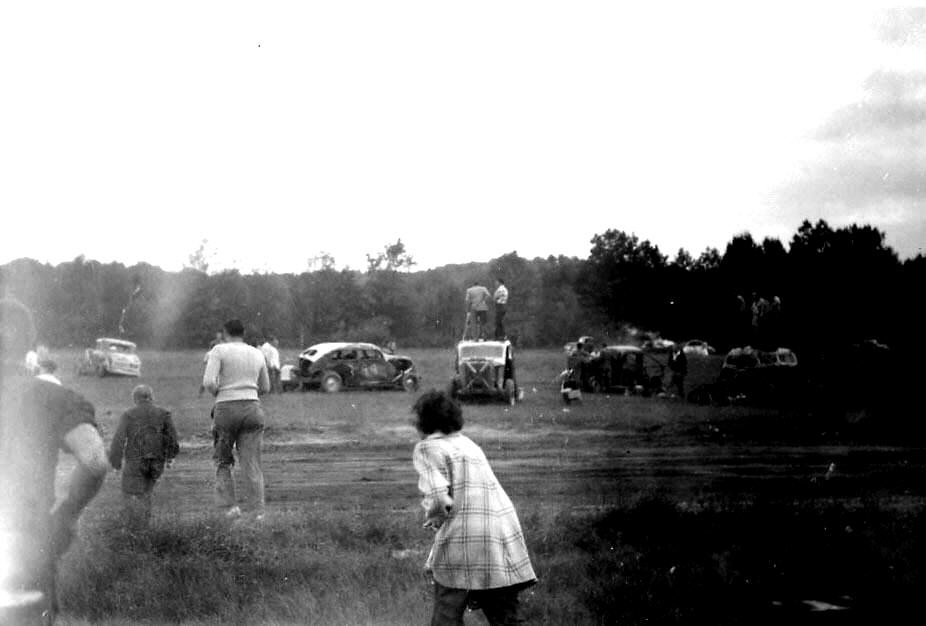
Courtesy of Alan and Andy Ward
Clutching a thin, early -
fifties – style car coat [and probably her pack of cigarettes], a woman starts
across
the track at Morrisville. Perhaps this was the onset of the riot , another
wreck, or both.
Kincaid, who was a crusty sort of guy; but, still he was just another working
man who reportedly liked motorcycles and had a job – just like most of the other
drivers. Kincaid, whose wife was named Olive, showed up with his family at the
crude Morrisville track the following week. That may not have been the best
idea, given what he was there for.
In a story
that sounds like something out of a B-movie, Kincaid came to town with the
reputation of being a hit man who had raced the tracks of foreign lands (well,
Quebec to be precise). Kincaid showed up one week and promptly began putting out
the Burlington cars. Squier recollects he rolled about four cars, including that
driven by the popular Ronny "Rollover" Farnsworth. Alton Hedges took to the
track with a very nice – looking car that week, and he was the last to be done
in by the Killer. Squier said that, as the race drew to a close, Kincaid
realized he was not going to be well received in the pits; so he parked on the
track near the flatbed used by Squier and the track officials.
Courtesy of the Bob Bushey Family
Rex Shattuck pushes competitor Gordy Owen
into the infield at Colchester Raceway around 1951. Both of
these teams could have been at
Morrisville that fateful day. Below- Northerner Harold "\Cannonball" Baker
was one of the few from his region
to have a lighter, more competitive car. Baker's 5 is seen leading at
the very rough Enosburegh Speedway,
another venue where banging and aggression was the norm.
Courtesy of Bill Baker
He said Hedges came after Kincaid as he still sat in the car. Reaching into the car, Hedges began beating on Kincaid. Soon an all-out riot had started with most of the 400 or so people in attendance fighting. Squier and the track officials sought refuge under the flatbed and watched the donnybrook. The National Guard, which was holding their monthly training and drilling nearby, had to called out to put a stop to the fights. One of Squier's most vivid memories of the melee was of an older gentleman with a crutch. He just swung at away at anyone who came close to him! This incident served as the beginning of the end for Morrisville's little racetrack.
Squier said he believes they finished out the season, be he thinks that was the final year of auto racing in Lamoille County. A cursory search for information about the racetrack met with many dead ends. The local News & Citizen's dating from 1949 to 1951 contained no mention of the track or this brawl. But this article did turn up several photos from a woman in Johnson who remembered attending the track as a child and snapped shots with her Brownie.
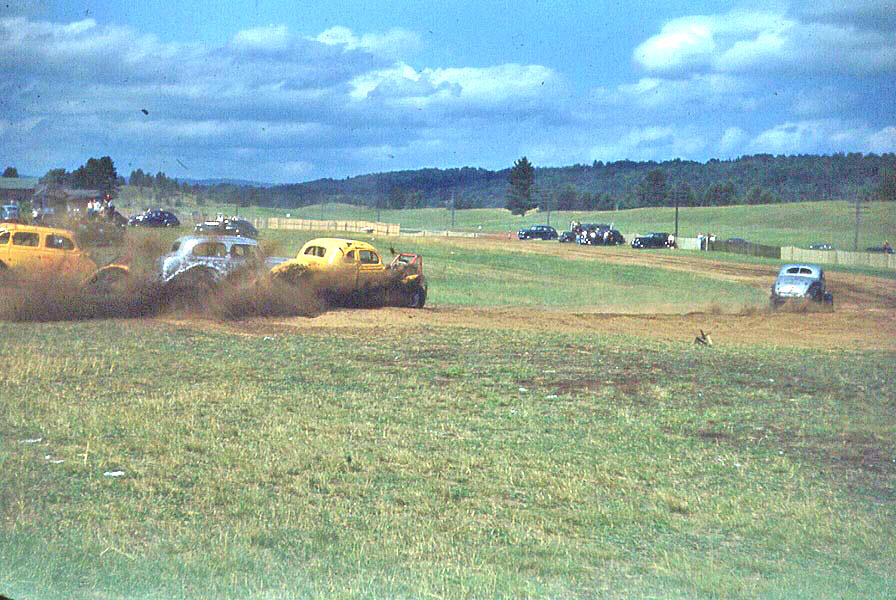
Courtesy of the Bigelow Family
Cars similar to those of Morrisville
churn up the loose dirt surface of the Webster Flats track near Lyndonville.
It was only slightly more organized and – very likely – Conley had a hand
in its operation.
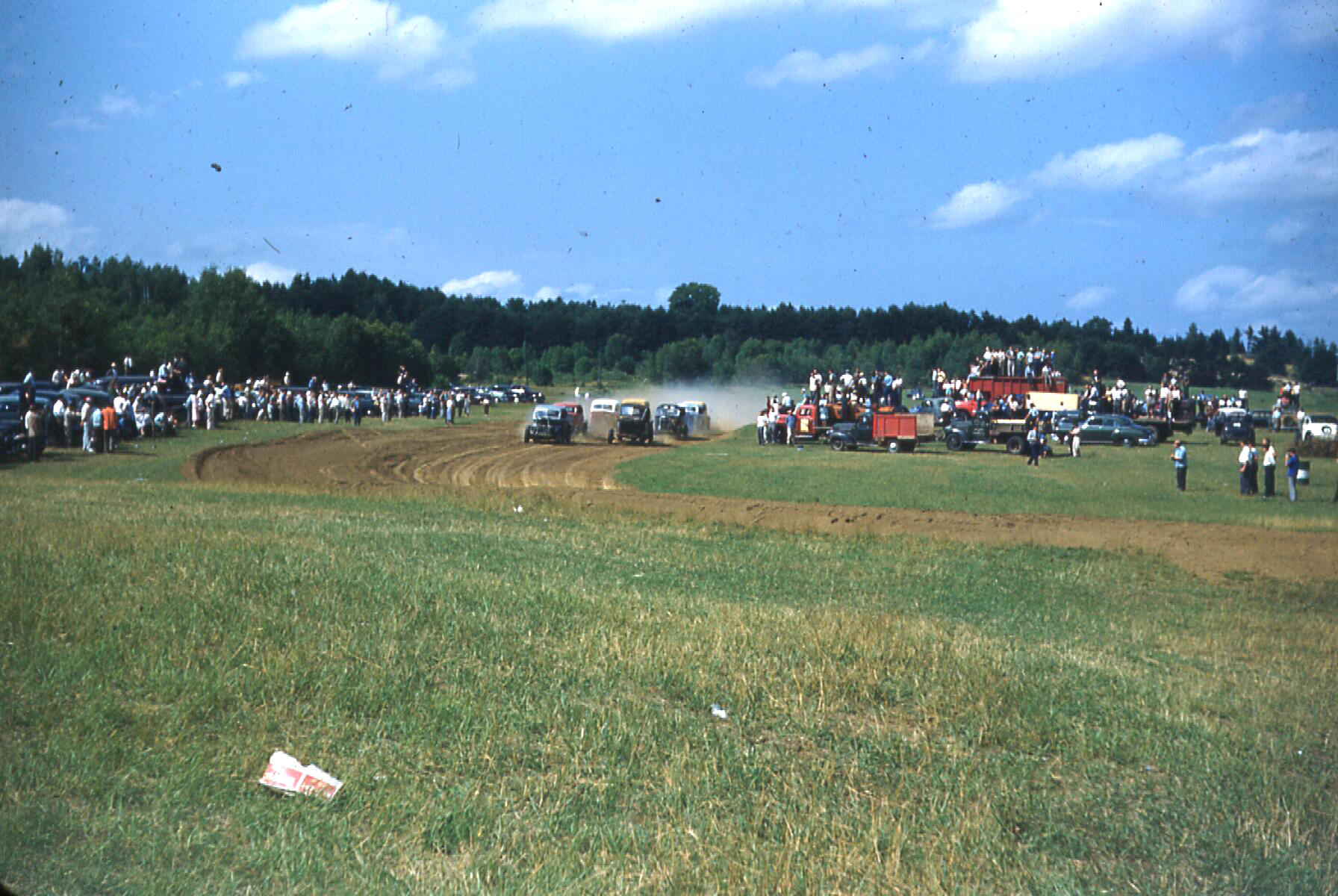
Courtesy of the Gerald Bigelow Family
Although tracks would exist in Sheffield, Sheldon, Concord, and several other venues within an hour’s drive of Morrisville, the apparently unnamed pasture track had a very short life and a relatively small role in the crowded history of Vermont stock car racing – which was particularly crowded in the early 1950’s. Today, a stroll around the grounds of the school or a scan overhead on Google Earth produces not the slightest trace of the track.
A few people who may have been involved with that track occasionally surface, but few have clear memories of it. Squier, of course, went on to a remarkable career in broadcasting and in ownership of the state’s two most successful race tracks – Thunder Road International Speedbowl and Catamount Stadium. Conley became a prominent citizen in Irasburg, Vermont, owning a number of businesses and serving as the chairman of the Orleans Central School District. According to Google Earth, one of his businesses is remarkably close to the site of another race track [In Sheffield] – another short – lived race venue.
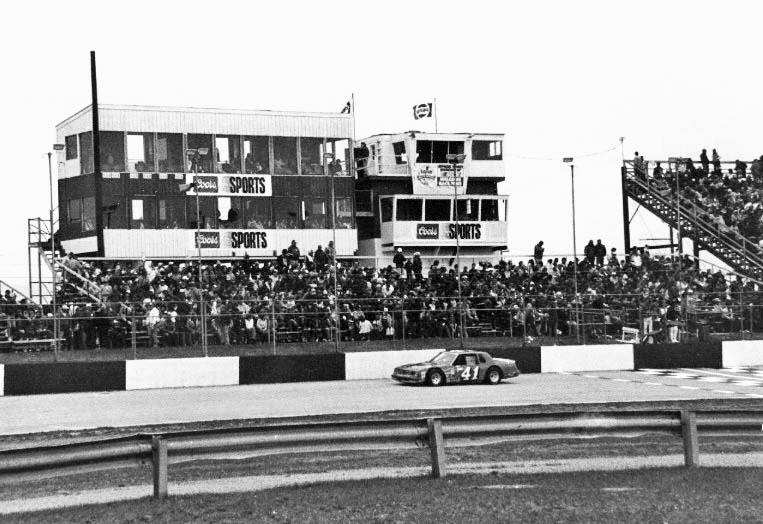
Ladabouche Collection
Racing developed dramatically in the
career of Morrisville’s young announcer. This is Ken Squier’s
state – of – the – art Catamount Stadium track, as it looked around 1985.
Conley was touched by controversy, one more, highly – visible time, when his son was connected with the infamous Irasburg scandal involving violence against an African - American minister, and some alleged marital infidelity thrown in for good measure. Four or five local young people were convicted of a southern – style nightrider shooting into the minister’s residence. The incident got national attention in the racially – charged late 1960’s and served to show another parallel in that region [besides grassroots stock car racing] to the South.
To add further irony, today if Conley had been trying to get his race promotions off the ground with Vemont media, he would have had some inside help. One of the more important members of Vermont’s CBS affiliate WCAX, today, is reporter and anchorman Derron Perron, Conley’s maternal grandson.
Racing in Vermont [and, for that matter, in most states], from dozens of hastily – built places like the pasture track in Morrisville, to far fewer and more sophisticated tracks. The high water mark for the number of tracks in Vermont was probably around 1951. The high water mark for modern racing facilities was probably reached, around 1986, at Milton, Vermont’s Catamount Stadium, a track co – owned by Ken Squier.
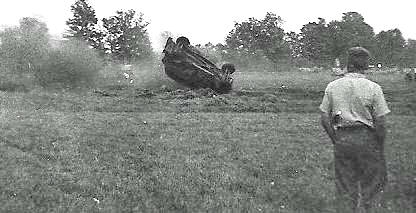
Courtesy of Charlie Smith
The beginning of yet another roll at
Morrisville. The onlooker seems somewhat unimpressed. Below - The next
rollover must have been more spectacular. A woman
reacts in terror at what she sees.
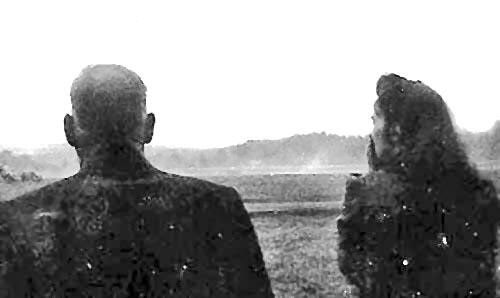
Courtesy of Charlie Smith
Few participants today understand how the sport in which they participate got started – unless they listen to the stories told in small knots of old men, standing off the side at events like Thunder Road’s Milk Bowl. There, you will still hear about men flying about in unsafe jalopies, held in with belts made of horse harness, and risking life and limb for a case of cheap motor oil. Such was Morrisville, in the start of the 1950’s.
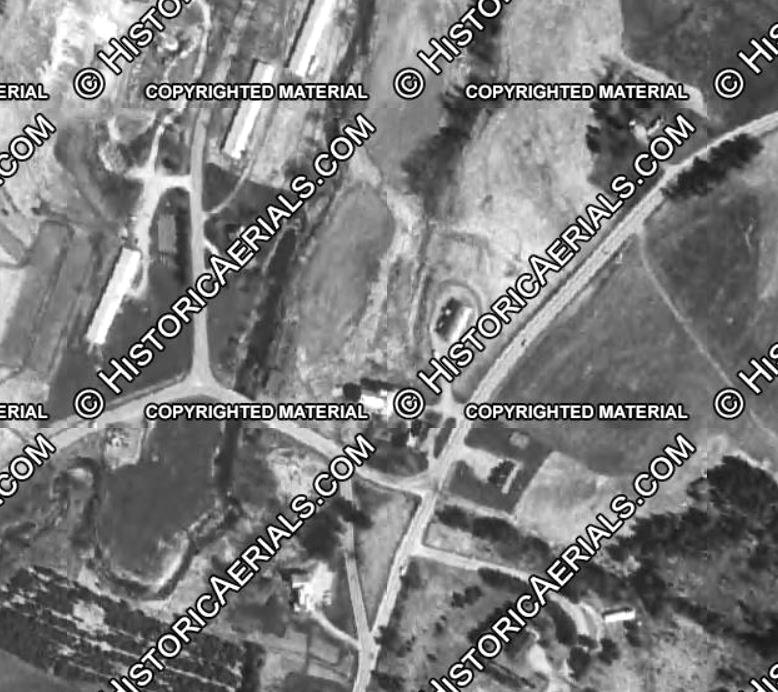
Courtesy of Historic Aerials.com
I finally found an aerial of the track
location - just off Route 100. The track is directly in
the middle of the photo in the angle formed by the
lettering "HistoricAerials" and:Copyrighted
Material".
Please email me if you have any photos to lend me or information and corrections I could benefit from. Please do not submit anything you are not willing to allow me to use on my website - and thanks. Email is: wladabou@comcast.net . For those who still don’t like computers - my regular address is: Bill Ladabouche, 23 York Street, Swanton, Vermont 05488.
AS ALWAYS, DON’T FORGET TO CHECK OUT MY WEBSITE
www.catamountstadium.com
Return to the Main Page
Return to the Main News Page
Return to the All Links Page
Return to the Weekly Blog Links Page